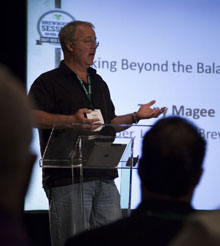
At least that’s what he did when he launched his IPA brand back in the early 1990’s – a move that, at least now, seems prescient.
“I wanted to find my own path through the world,” he said. “I realized that an IPA is a premium version of a pale ale.”
So instead of chasing his neighbor – the much larger Sierra Nevada – Magee made his flagship offering an IPA and also he made sure the label “could be read from the parking lot.”
The move paid off. Magee said the company continues to grow the brand at 45 percent in the grocery channel, despite stiff competition from hundreds of new breweries.
“Because they [grocery customers] aren’t us,” he said. “They aren’t beer geeks. They don’t know every flavor of IPA.”
Magee described this acute emphasis on branding during the Nov. 29 Brewbound Session in San Diego. There, he addressed over 130 brewers, distributors and beer industry members, discussing the humble beginnings of Lagunitas, which produced just 600 barrels in its first year but is currently on pace to sell 420,000 barrels in 2013.
When he started his company “on his wife’s kitchen stove” in 1993, Magee elected to zig while his competitors zagged. Instead of brewing up another me-too amber ale or trying to compete with Sierra Nevada, Magee became the first California brewery to offer an IPA as its flagship.
“Our basic strategy was to change the game,” he said.
Magee urged fellow brewers in the audience to do the same.
“Changing the game and having your own voice has never ever been more important than it is right now,” he said. “You have to reach way deep down inside of yourself to find it.”
And while Lagunitas has certainly found its voice, Magee questions whether the nearly 1,400 breweries in planning have found theirs. During his speech, he called out the “thousands of me-too brewers,” citing category excitement as the catalyst. But despite the rush of new entrants, Magee said he still believes that a proverbial forest fire – a category shakeout – looms in the distance.
“The forest service has no idea where the forest fires are going to be, how big they are going to be, or when they will start, but everyone knows they are going to happen,” he said. “You have to be prepared for the fire that is going to come, and I think there will be a fire.”
But despite the threat of a bubble bursting, Magee said there is “little risk” in excess capacity over the next four or five years — in fact, he said, he envisions a beer landscape where 50 percent of the production comes from craft brewers. The way he sees it, there will be an $800 million gap in craft supply coming from craft brewers over that time.
“There is an enormous opportunity, which is why I am putting the brewery in Chicago,” he said. “It will be the people that can make the beer that get to sell it.”
Magee’s long term vision is a 200 million-barrel U.S. beer landscape in which global mega-brewers account for 100 million barrels, large ‘craft’ players control 80 million barrels and smaller, local brands brew up the remaining 20 million barrels.
And how about Magee’s long term vision of his own company?
“It’s a hard thing to know,” he said. “For me, I want someone to say my name 100 years from now.”